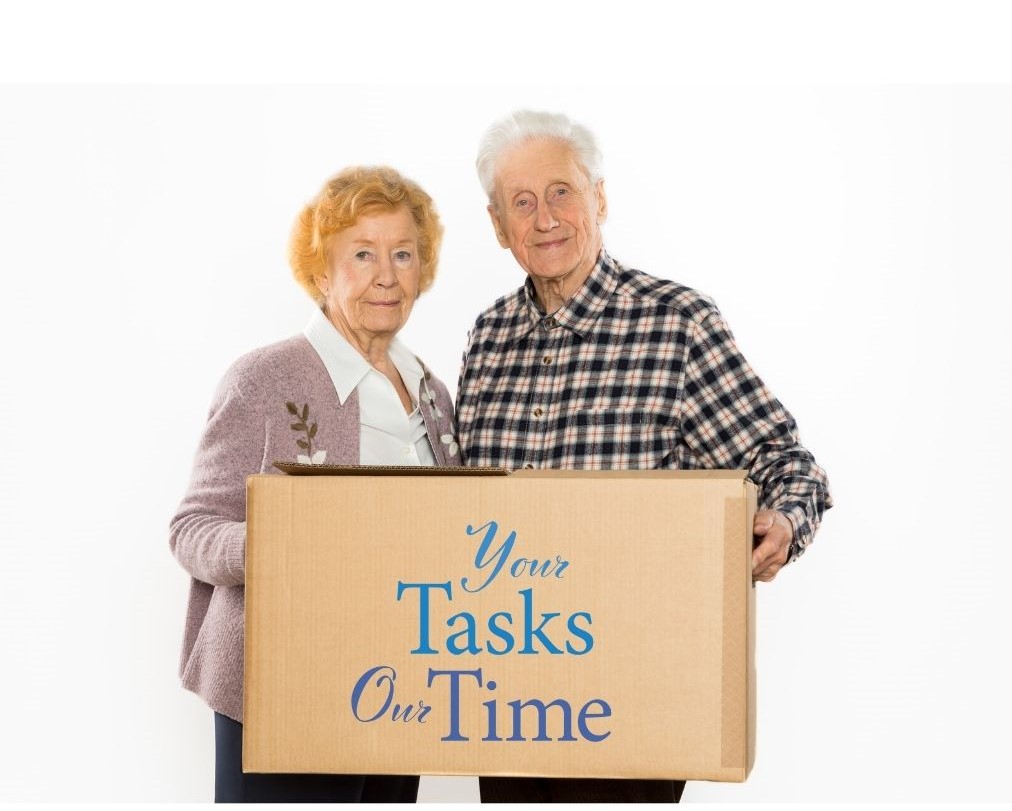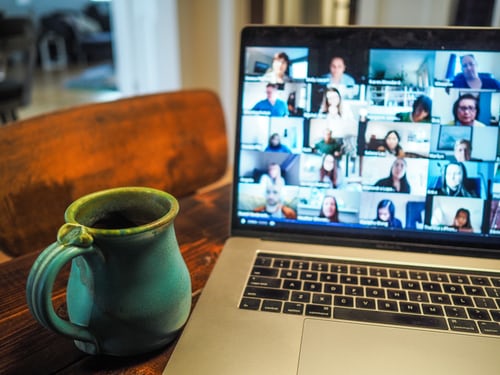By Darla Pompilio, (610) 847 5422, Your Tasks, Our Time

Do you have a parent or senior in your life that could benefit from downsizing their home but
you’re not sure how to approach the discussion? The topic of downsizing can be a difficult for
some. They may have to part with items that have memories attached. Or it may make them
feel like they are losing a piece of themselves. Below are some key aspects to ensure you have a
supportive and respectful discussion with the seniors in your life.
Before You Begin the Conversation
Before you start the conversation with your loved one, keep a few things in mind.
Be Respectful and Non-Judgmental
A Senior’s possessions represent a lifetime of memories. Dismissing their value as worthless is
equal to dismissing the senior’s value.
Don’t Lecture
Most seniors will respond well if you share your concerns and express your desire for them to
be in a safe and comfortable environment. It’s not about forcing them to get rid of things, it’s
about helping them to live their best life.
How to Begin the Conversation
How you start the conversation, and the tone you use, can impact the discussion either positively or negatively. Come from a place of support and love so they understand your desire to help them. Below is a list of questions you can use to get the conversation started.
Open-ended questions will be better to gain more information.
During the Conversation
Getting the conversation started is a step in the right direction. Keeping the conversation going in a positive direction is just as important. Remember these key points as you progress through your discussion.
Simply Listen
This is probably the most important step in the process. When seniors let go of their possessions, it often feels like a loss of control. By listening to their wants, needs and desires, you’re helping to ensure that they are maintaining control.
Ask Questions
Allowing seniors to tell stories about the past as you sort through their possessions can help ease some of the anxiety during the process of letting go.
Pick Your Battles
Arguing over every item is going to end with lots of hurt feelings and no progress. Letting go takes practice and patience. Keep reminding your loved one of the ultimate goal … for them to live their best life. It will get easier as they become more comfortable with letting go.
This process won’t be done overnight. It’s not uncommon to go through an entire home 2 to 3 times to achieve the desired goals. So be kind. Be patient. And remember, you may be in a similar situation yourself in the future.


By Russell Pitcairn, The Junkluggers, (215) 779 1644
Recently, I asked my network to share several of their favorite books. Below is a list of inspirational books along with their own key takeaway. Feel free to comment if you have read any of the books below. Let me know if you have a favorite book that has inspired you. Please enjoy!
“Who Moved My Cheese” by Spencer Johnson
Linda’s Key Takeaway: Be Flexible
“The Tipping Point” By Malcolm Gladwell
Linda’s Key Takeaway: Keep your eyes and mind open at a high level.
“The Purple Cow” By Seth Godin
Nate’s Key Takeaway: Companies that have grown into large successful organizations did so by offering a remarkable service or product. In order to succeed in the same industry, you must offer SOMETHING ELSE that is remarkable, stands out, and talks to the people. It’s the only way to be successful in the long run.
“The Go Giver” By Bob Burg and John David Mann
“A Complaint Free World” By Will Bowen
Linda’s Key Takeaway: Be aware, stop and surround yourself with those that come up with solutions…not complaints.
“Wild: From Lost to Found on The Pacific Crest Trail” By Cheryl Strayed
Linda’s Key Takeaway: Get out of your comfort zone.
“Resilience” By Eric Greitens
“Never Split the Difference” By Chris Voss.
Russell’s Key Takeaway: If someone gives you a response you do not like, ask open ended questions like “Why?” or “How?” This may reveal key information, or may get the other person to come up with a different response.
“One Small Step Can Change Your Life” By Robert Maurer
Linda’s Key Takeaway: Move with intention and control.
“Welcoming the Unwelcome” By Pema Chodron
Darla’s Key Takeaway: The time we live in is a fertile ground for training in being open-minded and open-hearted. If we can learn to hold this falling apart-ness without polarization and without becoming fundamentalists, then whatever we do today will have a positive effect on the future.
“A Fine Mess” By TR Reid
Blair’s Key Takeaway: Understanding America’s tax system and an effective way to restructure it. Lower tax rates but eliminate deductions/ways people avoid them, but broaden the tax base/tax on spending of earnings.
Infants grow fast — I’ve had piles of clothes to prove this fact. Nearly as fast as they’ve grown into their newest cute new outfits, they’ve outgrown them already! Having a plan for keeping up with this constant rotation will save you time in the future and reduce the stress of potential growing piles. Whether or not you hope to use the clothes for future children, here are a few quick-to-tackle tips for getting ahead of the clothing clutter.
Not saving anything? Get ahead of the clutter.
Determine the spot you’ll use for temporarily stashing outgrown items. I use a basket under my son’s crib, but you can use a paper bag, box, or large trash bag on a shelf or in a closet. The laundry room is a great place, too. From now on, every time you determine something no longer fits your child, put it in your temporary storage bin. Add to this bin until it’s full, then mark it with the approximate size(s), stick the box/bag in your car, and drop it off for donation. Likely you have friends with kids and could also drop off the box on a porch for hand-me-downs. More on donations at the end.
If you know you’ll be keeping some clothes for future children, read on.
Get Clothes Prepped for Future Kids
First, determine a spot you’ll use for temporarily stashing outgrown items. I use two baskets under my son’s crib, one for items I’m keeping and one for giving away, but you can use paper bags or boxes in the laundry room, on a shelf or in a closet, or large trash bags (clearly marked and stored out of reach of the littles), etc.
Next, Every.Single.Day and Every.Time you determine something no longer fits your child, decide if you liked this outfit/item and put it in the keep bin, if not, put it in your give-away bin. Add to these bins until full. Then transfer the give-away items to a box marked with the approximate size(s) and check out donation options below. For the clothes you’re keeping, transfer to a storage bin, vacuum sealed bag or other favorite storage solution. I tend to have extra diapers that are outgrown, so I fill diaper boxes with unused/outgrown diapers and clothing from roughly the same size. Taking 1 minute each day will save you the hassle of sorting through a huge pile later.
Options for Clothes You’re Not Keeping
Depending on your interest and time commitment, you have a few options in addition to those mentioned above. From approximately most to least time consumed:
Final Thoughts on Outgrown Clothing
It’s best to donate items you’d use again and toss anything too worn out. If your kids are older and aware of “favorite” pieces, go through this process with them, so they learn from you how to stay organized and be generous with their clothes! For the babies, an everyday, constant rotation keeps clothes that fit available and stops piles from accumulating to keep the nursery looking lovely.

Day 365 + ???? (who’s counting) of the pandemic and it seems like everyone is decluttering. We’re all trying to hold true to our reoccurring New Year’s Resolution to ”Get Organized.” Getting Organized can mean different things to us but it usually involves some sorting and culling of categories of stuff.
In our experience, there are always 3 decision buckets your stuff will fall into:
Our NAPO colleague, Barbara Hemphill, coined this brilliant definition: Clutter is Postponed Decisions.™ Clutter builds when we postpone decisions about:
• Do I really love it?
• Will I use it?
• Does it fill a void in my life?
• If I’m keeping it, where should it live?
While you do need to decide about your stuff, you do NOT want to stop the decluttering process to ponder each individual item.
Our time-saving advice is DEFER your decision for the “maybes” and “I don’t knows.”
These tricky decisions deserve attention — but NOT while you’re in the initial stages of rapid-fire, gut reactions to your stuff.
If you stop your intuitive process of deciding Yes, No, Maybe you won’t get through the whole category of stuff and you won’t see visible signs of progress. This will feel depressing and probably halt the whole decluttering process.
Follow our advice and schedule time with yourself — on a separate day — when your mind is fresh and you’ll taste sweet success. Technically, it’s called time chunking. In practice:
• One organizing session is dedicated to quick, visceral decisions.
• Another for contemplative, thoughtful and reasoned thinking.
Permission granted to defer your decisions on all of your “maybes” and “I don’t knows” — not because pushing off until tomorrow is a winning strategy. Permission granted because setting aside the necessary time to consider what deserves a place and space in your life is worthy of your full attention. In this case, deferring the decision is a smart move.
If you only had a few hours to evacuate your home because of an emergency (health- or weather-related), could you determine and locate your essential information, documents and resources?
Hurricanes, wildfires, tornadoes and a global pandemic….to say that 2020 has been a challenging year is an understatement. National Preparedness Month is recognized each September and the theme for 2020 is apropos – “Disasters Don’t Wait. Make Your Plan Today.”
In an emergency, the last thing you should be doing is scurrying to find extra batteries, locating essential documents, and worrying if your insurance is updated. It is critical to have easy access to important documents, records, and resources in the event of an evacuation or emergency.
Thinking through the details and your priorities when you are not in the midst of a crisis is vitally important.
DOCUMENT – the information and resources you already have (for example, your health insurance information, your ‘in case of emergency’ contacts).
Tip: Store your important documents in the Cloud which affords you access no matter where you are. Alternatively, if you plan to keep your documents in a paper-format, store them in one binder/folder and consider laminating.
CONSIDER – the information and resources you may need in an emergency (for example, flood insurance, extra prescription medicine).
Tip: Prepare an emergency kit with the essentials.
ORGANIZE – the information for easy access. Having everything in just a few places, rather than scattered through the house, is a good idea.
Tip: Create a roadmap (in a physical or digital binder) that details where the information and documents are located. My Life Packet is a comprehensive life and legacy affairs organizing workbook that guides you through the process.
SHARE – your plan with your loved ones.
Tip: Establish a family communication plan.
Taking inventory of what you would need in an emergency can save you and your family time, money, and stress. Although it may feel overwhelming, organizing and taking inventory of key information will not only help you ‘weather’ a storm, it will also create peace of mind.
Ah, new relationships! They can be fun and exciting, right? You love being together every day, you fall deep into the honeymoon period, and you feel that your partner is the best thing ever…
Hmm…do you remember mid-March, and a certain technology that blew up? Read the sentence above replacing Zoom with your partner…still works, right!
Yes, Zoom! I remember that gut wrenching feeling of being alone when we first learned that much of the world had shut down. Add living alone to that and it can really throw you for a loop.
My networking group started moving onto the platform that many of us were just starting to learn about. Working through kinks, like Zoom bombers, the leaders of our group helped us navigate through our new normal and suddenly I was with my friends again! It felt SO good!
I was on every day for a while, either networking, with friends, or with family, going to Zoom birthday parties and gathering for Zoom trivia nights. On my birthday in May, my friends threw me a surprise Zoom birthday and more friends appeared flash mob style to one of my favorite songs.
I loved Zoom! I couldn’t get enough of Zoom, until the day came that I could. Just like the honeymoon phase in a relationship, my relationship with Zoom peaked, and I reached the level of Zoom Fatigue, which many of us are facing today.
I just didn’t want to be on it anymore and faced that alone feeling again. I learned to fill my days in different ways, and after a while, as the world was starting to open up a bit, I started new routines with more balance.
Zoom is still a part of my new normal. I became a part of an accountability group with a few friends, go to a few networking meetings a week and even started virtual organizing with clients.
If you are still in the fog of Zoom Fatigue, here are some things to try to make being on it fun again:
So, learn to love Zoom again, but try to keep a life balance, and leave the honeymoon period for people, not the latest tech craze. Wishing you, your family, and your friends, a happy and healthy Fall!
